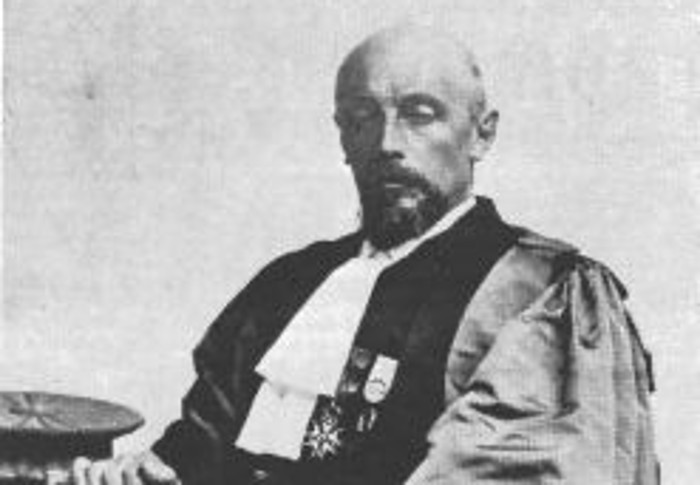
In 1903, French physicist Prosper-René Blondlot decided he had discovered a new form of radiation. But the mysterious rays had some exceedingly odd properties, and scientists in other countries had trouble seeing them at all. In this week’s episode of the Futility Closet podcast we’ll tell the story of N-rays, a cautionary tale of self-deception.
We’ll also recount another appalling marathon and puzzle over a worthless package.
Intro:
Franz Bibfeldt is an invisible scholar at the University of Chicago divinity school.
Sources for our feature on Prosper-René Blondlot and the N-rays:
René Blondlot, Julien François, and William Garcin, “N” Rays: A Collection of Papers Communicated to the Academy of Sciences, With Additional Notes and Instructions for the Construction of Phosphorescent Screens, 1905.
William Seabrook, Doctor Wood, 1941.
Walter Gratzer, The Undergrowth of Science: Delusion, Self-Deception, and Human Frailty, 2001.
Terence Hines, Pseudoscience and the Paranormal, 2003.
Richard C. Brown, Are Science and Mathematics Socially Constructed?, 2009.
Robert W. Proctor and E.J. Capaldi, Psychology of Science: Implicit and Explicit Processes, 2012.
Paul Collins, Banvard’s Folly, 2015.
Roelf Bolt, The Encyclopaedia of Liars and Deceivers, 2014.
Walter Gratzer and Walter Bruno Gratzer, Eurekas and Euphorias: The Oxford Book of Scientific Anecdotes, 2004.
Robert W. Wood, How to Tell the Birds From the Flowers, 1907.
Robert W. Wood, “The n-Rays,” Nature 70:1822 (1904), 530-531.
Mary Jo Nye, “N-Rays: An Episode in the History and Psychology of Science,” Historical Studies in the Physical Sciences 11:1 (1980), 125-156.
Robert T. Lagemann, “New Light on Old Rays: N Rays,” American Journal of Physics 45:281 (1977), 281-284.
Irving M. Klotz, “The N-ray Affair,” Scientific American 242:5 (1980), 168-175.
John Butler Burke, “The Blondlot n-Rays,” Nature 70 (June 30, 1904), 198.
John Butler Burke, “The Blondlot n-Rays,” Nature 69 (Feb. 18, 1904), 365.
Jeffrey Kovac, “Reverence and Ethics in Science,” Science and Engineering Ethics 19:3 (September 2013), 745-56.
Nancy S. Hall, “The Key Role of Replication in Science,” Chronicle of Higher Education 47:11 (Nov. 10, 2000), B14.
“The Blondlot Rays,” British Medical Journal 1:2245 (Jan. 9, 1904), 90.
“The Romance of the Blondlot Rays,” British Medical Journal 1:2244 (Jan. 2, 1904), 35-36.
“Blondlot and Prof. Wood on the N-Rays,” Scientific American 91:25 (Dec. 17, 1904), 426.
Malcolm Ashmore, “The Theatre of the Blind: Starring a Promethean Prankster, a Phoney Phenomenon, a Prism, a Pocket, and a Piece of Wood,” Social Studies of Science 23:1 (1993), 67-106.
Luis Campos, “The Birth of Living Radium,” Representations 97:1 (Winter 2007), 1-27.
“The Latest Wonder of Science,” Public Opinion 4:36 (Jan. 28, 1904), 115-116.
J.J. Stewart, “The N-Rays of Blondlot,” Knowledge & Scientific News 2:10 (September 1905), 218-219.
“Science and Invention: Radio-Activity,” Current Literature 38:3 (March 1905), 258.
J.R. Whitehead, “Radioactivity and Radiation,” Electrical World and Engineer 43:7, 310.
Mark Pilkington, “N-Rays Exposed,” Guardian, Sept. 1, 2004.
“Latest Scientific Discovery,” Leavenworth [Wash.] Echo, April 8, 1910, 4.
Listener mail:
Karen Abbott, “The 1904 Olympic Marathon May Have Been the Strangest Ever,” Smithsonian.com, Aug. 7, 2012.
Wikipedia, “1904 Summer Olympics” (accessed March 7, 2019).
Wikipedia, “Athletics at the 1904 Summer Olympics – Men’s Marathon” (accessed March 7, 2019).
Brian Cronin, “Sports Legend Revealed: A Marathon Runner Nearly Died Because of Drugs He Took to Help Him Win,” Los Angeles Times, Aug. 10, 2010.
Wikipedia, “George Eyser” (accessed March 9, 2019).
Wikipedia, “Andarín Carvajal” (accessed March 9, 2019).
“1956 Olympic Long Jump Champion Krzesinska Dies,” IAAF News, Dec. 30, 2015.
This week’s lateral thinking puzzle was contributed by listener Murli Ravi. Here are two corroborating links (warning — these spoil the puzzle).
You can listen using the player above, download this episode directly, or subscribe on Google Podcasts, on Apple Podcasts, or via the RSS feed at https://futilitycloset.libsyn.com/rss.
Please consider becoming a patron of Futility Closet — you can choose the amount you want to pledge, and we’ve set up some rewards to help thank you for your support. You can also make a one-time donation on the Support Us page of the Futility Closet website.
Many thanks to Doug Ross for the music in this episode.
If you have any questions or comments you can reach us at podcast@futilitycloset.com. Thanks for listening!
